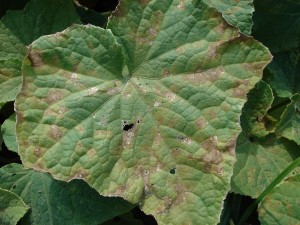Once cucurbit downy mildew (CDM) is detected in the mid-Atlantic region (as of yesterday in Maryland) all cucurbit growers in New Jersey should begin to include downy mildew specific fungicides in their weekly fungicide programs on all cucurbit crops.

Symptoms of cucurbit downy mildew on infected cucumber leaf.
All cucurbit growers who have not initiated a preventative fungicide program should do so. Importantly, in recent years, the efficacy of the different downy mildew specific fungicides has begun to vary among the different cucurbit crops. It is important to understand that this is most likely due to different pathotypes of the fungus be present, the fungus continually evolving, and the use of high-risk fungicides. Growers need to pay careful attention to what downy mildew fungicides are recommended for which cucurbit crop.
For cucurbits as well as all other crops in the recommendations guide, those fungicides listed at the top of the recommendations list have proven to be more effective than those listed near the bottom; note that one fungicide may be more effective on one cucurbit crop compared to another cucurbit crop.
Remember to tank mix all downy mildew specific fungicides with protectant fungicides such as chlorothalonil or manzozeb and rotate between downy mildew specific fungicides from the different FRAC groups to help reduce the chances for fungicide resistance development. For more information on controlling downy mildew on the different cucurbit crops please see the 2014 Commercial Vegetable Recommendation Guide.
To track the progress of cucurbit downy mildew in the US please visit http://cdm.ipmpipe.org/.

